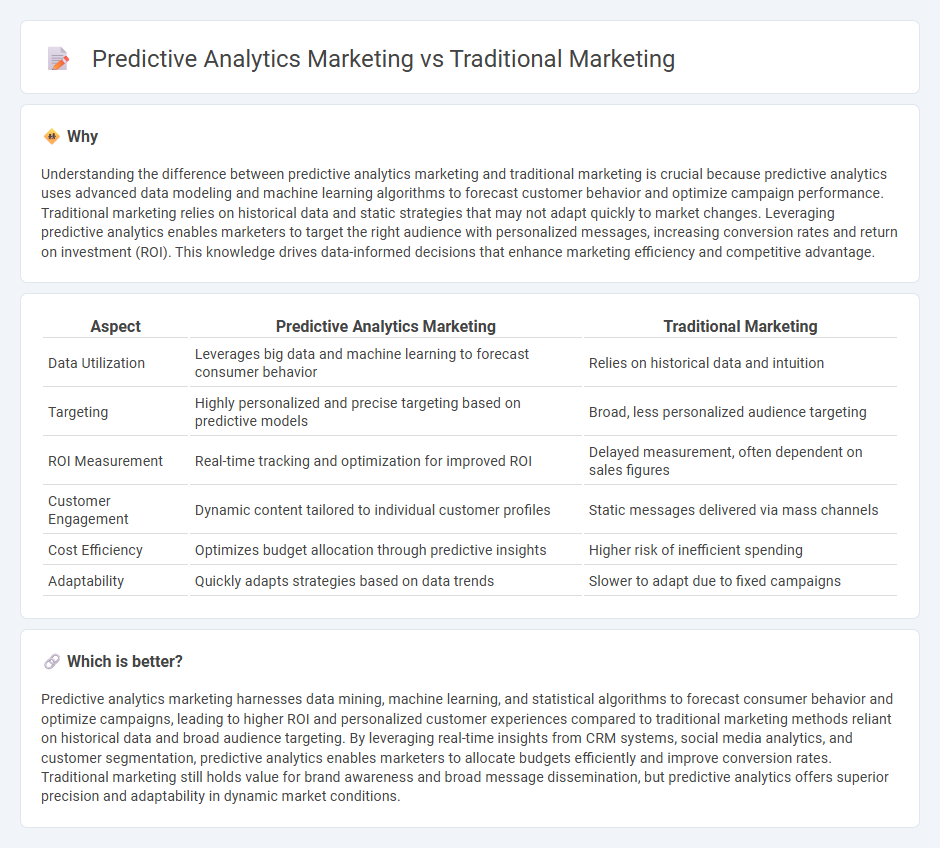
Predictive analytics marketing leverages data-driven algorithms and machine learning models to forecast customer behavior, enabling personalized campaigns and optimized budget allocation. Traditional marketing relies on historical data and intuition, often resulting in generalized strategies with less precise targeting and measurement. Explore how integrating predictive analytics can transform your marketing approach for improved ROI and customer engagement.
Why it is important
Understanding the difference between predictive analytics marketing and traditional marketing is crucial because predictive analytics uses advanced data modeling and machine learning algorithms to forecast customer behavior and optimize campaign performance. Traditional marketing relies on historical data and static strategies that may not adapt quickly to market changes. Leveraging predictive analytics enables marketers to target the right audience with personalized messages, increasing conversion rates and return on investment (ROI). This knowledge drives data-informed decisions that enhance marketing efficiency and competitive advantage.
Comparison Table
| Aspect | Predictive Analytics Marketing | Traditional Marketing |
|---|---|---|
| Data Utilization | Leverages big data and machine learning to forecast consumer behavior | Relies on historical data and intuition |
| Targeting | Highly personalized and precise targeting based on predictive models | Broad, less personalized audience targeting |
| ROI Measurement | Real-time tracking and optimization for improved ROI | Delayed measurement, often dependent on sales figures |
| Customer Engagement | Dynamic content tailored to individual customer profiles | Static messages delivered via mass channels |
| Cost Efficiency | Optimizes budget allocation through predictive insights | Higher risk of inefficient spending |
| Adaptability | Quickly adapts strategies based on data trends | Slower to adapt due to fixed campaigns |
Which is better?
Predictive analytics marketing harnesses data mining, machine learning, and statistical algorithms to forecast consumer behavior and optimize campaigns, leading to higher ROI and personalized customer experiences compared to traditional marketing methods reliant on historical data and broad audience targeting. By leveraging real-time insights from CRM systems, social media analytics, and customer segmentation, predictive analytics enables marketers to allocate budgets efficiently and improve conversion rates. Traditional marketing still holds value for brand awareness and broad message dissemination, but predictive analytics offers superior precision and adaptability in dynamic market conditions.
Connection
Predictive analytics marketing leverages data-driven models to forecast consumer behavior, enhancing the strategic targeting foundational to traditional marketing methods. Integrating these predictive insights allows marketers to optimize campaign budgets, improve customer segmentation, and increase conversion rates effectively. This synergy between data analytics and established marketing principles drives more personalized and efficient promotional strategies.
Key Terms
**Traditional Marketing:**
Traditional marketing relies on established methods such as print ads, TV commercials, and direct mail campaigns to reach broad audiences, emphasizing brand awareness and mass appeal. It often uses demographic data and historical trends to guide marketing strategies without real-time adjustments. Discover how integrating predictive analytics can transform your marketing effectiveness beyond traditional approaches.
Mass Media
Traditional marketing relies heavily on mass media channels such as TV, radio, and print to reach broad audiences without granular targeting, resulting in less personalized messaging and higher overall costs. Predictive analytics marketing leverages data-driven insights to identify and target specific consumer segments through digital platforms, optimizing media spend and enhancing campaign effectiveness. Explore how integrating predictive analytics can transform your mass media strategies for superior ROI.
Demographics
Traditional marketing primarily targets broad demographic segments such as age, gender, income, and location to tailor messages and media channels for maximum reach. Predictive analytics marketing goes further by analyzing behavioral data and purchase history within these demographics to forecast future actions and personalize campaigns with higher precision. Explore how integrating demographic insights with predictive algorithms can transform your marketing strategy.
Source and External Links
What is Traditional Marketing? Definition, Types and Examples - Traditional marketing uses conventional offline methods such as print ads, TV commercials, radio spots, billboards, and direct mail to promote products or services and build brand recognition through broad exposure.
Traditional Marketing : Meaning, Importance, Channels, Advantages and Disadvantages - Traditional marketing relies on offline media like print, radio, TV, billboards, and direct mail to engage customers, especially reaching those less active online, and helps build brand awareness and credibility through tangible interactions.
The Difference between Traditional and Digital Marketing? - Traditional marketing includes non-digital advertising methods such as print marketing, broadcast marketing (TV and radio), direct mail, outdoor ads, and cold calling, targeting specific geographic areas or audiences with tangible products.
 dowidth.com
dowidth.com